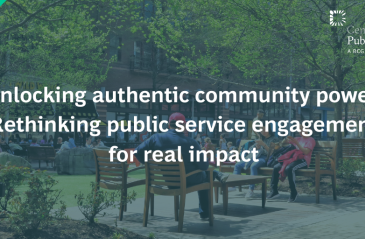
The power of storytelling in climate leadership

Buffalo's @omestrejr is using his architect training to design new services for city citizens
Share articleBuffalo residents can now call a hot line to report issues which need addressing by city managers
Share articleA citizen-facing open data portal will shortly go online for Buffalo residents to access
Share articleWe put our vision for government into practice through learning partner projects that align with our values and help reimagine government so that it works for everyone.
Buffalo may be more famous for its blue collar roots, but this city in upstate New York is very much pulsing with the energy of its more famous neighbour to the south.
Today, the city's chimney stacks lie dormant, but in their place have come industries - financial, technology and engineering - and new districts, like the waterfront, now a thriving quarter of bars, restaurants and sports which attracts 750,000 visitors a year. It's the sort of place, according to Oswaldo Mestre, the city's director of citizen services and chief service officer (CSO), which can easily become your home. Which is exactly what happened to him, having stayed on after studying architecture and design at the city's university.
"Government and public policy is actually very similar to architecture and design," he observes. "I am always looking at projects from a design perspective and seeing how they can be made better. This is because architects are always trying to build and understand shapes and spaces for the benefit of the community." Mestre is clearly doing something right - he recently joined Beth Blauer, and 22 other government leaders as one of GovTech magazine's Top 25 Doers, Dreamers and Drivers of 2017.
Mestre's close partner in all things Buffalo is the city's mayor, Byron Brown, who is currently in the midst of running for an unprecedented fourth four-year term. On his watch, the city has advanced in many areas, not least its financial situation.
"When he came on board, our city finances were really in rough shape," recalls Mestre. "We had gone over our taxable spending limit and there were just a lot of challenges financially. We no longer have these problems, as we have balanced the budget throughout his tenure. He is enjoying great support because he helped turn around the city. My job is to interpret what he wants to do and where he wants to go." Fortunately, the pair share a similar outlook when it comes to trying new approaches and aiming high.
"I'm the one appointee who has worked for two different mayors," he says - a testament to his long years of service as well as his positive impact. "Certainly, part of being CSO and director of the Division of Citizen Services is to try new things, and I'm certainly a 'push-the-envelope' kind of guy. I try to fix on the idea of how data affects people - and make decisions accordingly."
A good example of this is the city's new 311 system, which enables Buffalo residents to call a toll-free number and report any issue in their neighbourhood, like a broken streetlight or pothole, that needs addressing by the city government. "Before I got here, we didn't have a call centre," says Mestre. "Folks often call us, and some used to think it was just about them complaining and letting off some steam, but really it is about them telling us a story of what is going on out there, in the community, and we as public officials need to interpret that, and interpret it in a very fast way. I try to drive this forward."
The 311 system is just one example of how Buffalo's city government is seeking to use digital technology to deepen its connection with the community. Another is its effort to move forward on open data, one of the projects Mestre is working on at the moment. This initiative has led to the creation of an open data policy for the city and a citizen-facing open portal, which will soon be coming on stream. "The mayor asked me to spearhead this project, and I truly believe it's the next step as we move more and more towards becoming a truly responsive city to our residents," he says.
The open data initiative will work in conjunction with Buffalo's CitiStat programme - another project which comes with the mayor's stamp of approval. "The mayor has been leading this process in terms of talking to various departments and identifying these different data sets," he explains. "It allows people in the community to have access to this information, and for departments to have access to it as well. This is very, very important because we can't respond quickly to citizens if we are siloed. And responding well and quickly should be in our DNA."
And this point is absolutely vital. Mestre's perspective is that citizens come first, always, so much so that engagement with the community is deeply woven through his entire approach. "I'm always thinking that whatever we are doing or planning, we have to have some community involvement in some way," he explains. "And so whenever we are introducing something new or different or innovative, I always want to garner some support within the community. We have a citizen advisory board that meets twice a year and I can run ideas past them, or if I am going out into the community and presenting I can do the same. It really is important we have that back and forth."
Mestre, then, is out and about in the city almost as much as he is behind his desk in City Hall. This interaction, he believes, is not only personally energising but also serves as a priceless opportunity to see and understand at first hand the concerns and needs of the citizens in his adopted home town.
"My connection to the community is very important to me," he concludes. "And when someone thanks us or praises our speedy response to a problem, then that's truly humbling and is exactly what this job is all about. It's not just the big data and technology; it's about these small incremental steps, too. It's truly about the democratisation of technology in this digital age and how people see themselves in the stories they want to share with us.”












